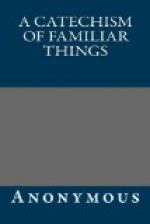Primitive, early.
Incense, perfumes
burnt in religious rites, or as an
offering to some deity.
What is the appearance of Frankincense?
It is generally imported in white or yellowish pieces, or drops, which possess a bitter, disagreeable taste; it is very inflammable, and burns with a strong, and pleasant odor. That brought from the Indies is inferior to that from Arabia, and inclines to a reddish color. The common frankincense is softer, more resinous, and possesses less value than the former.
What is Turpentine?
The resinous juice of many trees, as the pine, larch, fir, &c.; it is, in fact, the juice that renders them evergreen, and when in an over-abundant quantity, bursts through their bark, and oozes out. Common turpentine is that procured by incisions from the wild pine; there are several kinds of turpentine procured from various resinous trees; some are of use in medicine, and most of them in making different kinds of varnishes, for preserving and beautifying boxes, paintings, &c.
Ooze, to flow gently.
Is there not a tree more particularly designated the Turpentine Tree?
Yes, the Terebinth or Turpentine Tree of Palestine and the East. It is one of the most common forest trees of those regions, and is regarded with respect and distinction similar to that awarded to the oak in England.
What part of it produces the Gum?
The gum, or rather the resin, distils from the trunk. It is called Cyprus or Chian Turpentine, much of it being brought from the isles of Cyprus and Scio, or Chios, and is procured, by incision, about the month of July. This turpentine, owing to its superior quality, as well as its scarcity, each tree seldom yielding over two or three pounds, is very costly.
Incision, a cutting.
Costly, expensive.
CHAPTER XVI.
BRICKS, MORTAR, GRANITE, SLATE, LIMESTONE, OR CALCAREOUS ROCKS, STEEL, EARTHS, VOLCANOES, AND EARTHQUAKES.
Of what are Bricks composed?
Of clay, dried by the heat of the sun, or burnt in kilns; their color varies with the different degrees of heat to which they are subjected in burning. In the East, bricks were baked in the sun; the Romans used them crude, only laying them to dry in the air for a long space of time.
Crude, in the
rough, unbaked state, just as they were
formed.
How long have Bricks been in use for building?
Bricks appear to have been in use at a very remote period of antiquity, both from the account of them in the Holy Scriptures, and from the remains of them which have been found; the Tower of Babel and the walls of Babylon were built of them. They were in early use among the Egyptians, as appears from the history of the Jews before their deliverance by Moses. In the book of Exodus, we are told that this captive people were compelled to make bricks for that nation. The Romans, under their first kings, built with massive square stones; but towards the end of the Republic they began to use brick, borrowing the practice from the Greeks; and the greatest and most durable buildings of the succeeding Emperors were composed of them, as the Pantheon, &c.




